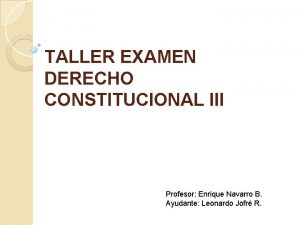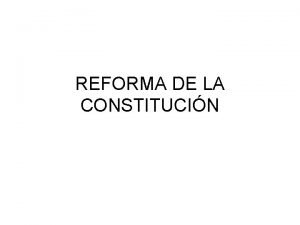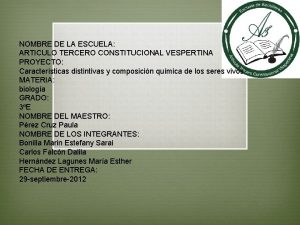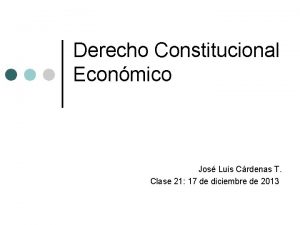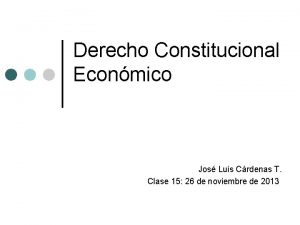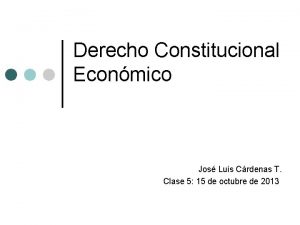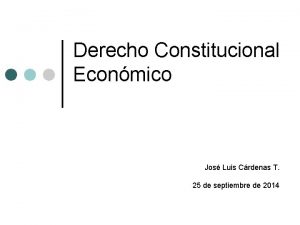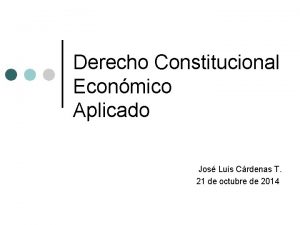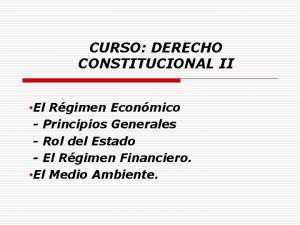Derecho Constitucional Econmico Jos Luis Crdenas T Clase






![No sólo hospitales & medicamentos … ¢ “[…] there are many activities outside the No sólo hospitales & medicamentos … ¢ “[…] there are many activities outside the](https://slidetodoc.com/presentation_image_h2/a004afa79d87d7668b4bd197b26931a7/image-7.jpg)















- Slides: 22

Derecho Constitucional Económico José Luis Cárdenas T. Clase 15: 21 de noviembre de 2013

Salud & Economía ¢ ¢ Salud: “Es el estado de completo bienestar físico, mental y social, y no solamente la ausencia de infecciones o enfermedades” (OMS, 1946) “[…] the health of a nation – defined broadly as its physical, mental and social functioning and ability to cope with life’s daily challenges – is one important determinant of national economic performance. Unhealthy societies do not prosper economically and often fail to achieve their economic potential, with adverse consequences for their citizens, including both present and future generations”. (WHO, 2003)

Salud & Economía ¢ In what specific ways can a nation’s health influence the performance of its economy, including (i) the performance of private sector enterprises; (ii) overall economic performance as measured by common economic indicators such as GDP growth, unemployment, inflation or income distribution; and (iii) the level of public expenditure required for social programmes, including health care? economic indicators such as GDP growth, unemployment, inflation or income distribution; and (iii) the level of public expenditure on social programmes including health care?

Salud & Economía ¢ ¢ In what specific ways can the provision of effective health care services improve the functioning of an economy and the health of a population? In what specific ways might the level and types of expenditure on health care services affect the economy? In what specific ways can the health of citizens and the need for health care be affected by the functioning of an economy, including (i) the performance of private sector enterprises; (ii) overall economic performance as measured by common economic indicators such as GDP growth, unemployment, inflation or income distribution; and (iii) the level of public expenditure on social programmes including health care?

Salud & Economía ¢ ¢ To the extent that a population’s health improves and all other factors remain constant, the need for health care in future should in theory decrease. If appropriate primary care services are established, or if life expectancy increases, the need for highly specialized acute, chronic or rehabilitative services will almost certainly be accentuated. Healthier populations are more productive populations in general. Good health may also have a feedback effect for individuals and families through higher incomes, which in turn permit higher standards of living and healthier lifestyles.

Salud & Economía ¢ ¢ ¢ Improvements in health that involve longer life expectancy as well as, or instead of, improved quality of life will affect the sociodemographic profile of populations in ways that will have implications for public expenditure, on pensions for example. Both for individuals and societies, prosperity is consistently associated with better health through both material and psychosocial pathways, some of which are only recently beginning to be understood. The commitment of resources to health care may also have direct effects on the economy which depend on the alternative uses to which those resources would have been put.
![No sólo hospitales medicamentos there are many activities outside the No sólo hospitales & medicamentos … ¢ “[…] there are many activities outside the](https://slidetodoc.com/presentation_image_h2/a004afa79d87d7668b4bd197b26931a7/image-7.jpg)
No sólo hospitales & medicamentos … ¢ “[…] there are many activities outside the health sector which, although they do not have health objectives, have very important health consequences. ” l l recycling and reuse of solid waste. job insecurity is associated with serious emotional, social and physical health outcomes. overuse of fertilizers ¿otros?

Algunos problemas estructurales … ¢ ¢ Many of the determinants of health (e. g. level of income, working conditions, social infrastructure) lie outside the scope of health ministries. Coordination of policies and cooperation with other ministries, particularly economic ministries, are critical to improving health through investments beyond health care. Health care has special characteristics which have led the governments of most industrialized countries to remove essential health services from private market allocation, for the most part. Economic tools cannot, therefore, be used uncritically with the health care industry in the way that they are used in other industries and sectors.

Algunas características del “Bien Salud” ¢ ¢ Unlike most goods and services, health care is not consumed for its own sake but for the expected positive contribution it will make to an individual’s health. Although the need for some health care such as preventive services may be foreseen, for the most part need is unpredictable because the incidence of illness or injury for an individual is itself unpredictable. Therefore some forms of insurance can be effective and efficient economic mechanisms for seeing that individuals in need receive services.

Algunas características del “Bien Salud” ¢ ¢ External effects associated with the consumption of health care and the health of individuals: An individual may be concerned about others’ health for selfish reasons, as in the case of infectious diseases, because another person’s ill health or failure to consume health care pose risks to him or her. Consumers are generally poorly informed about their need for specific health services and unable to evaluate in advance what the services will do for them. For this they require and consult health care providers, who act as their agents in deciding what they need to consume (asymmetric possession of knowledge).

¿Por qué no puro mercado? ¢ ¢ ¿Se cumplen los supuestos de una competencia efectiva para que el “bien salud” transado sólo en el mercado tienda a “óptimos sociales”? ¿Los demandantes del “bien salud” actúan como homo oeconomicus?

¿Por qué no puro mercado? ¢ ¢ Algunos problemas intrínsecos: efectos secundarios, indicaciones y contraindicaciones de medicamentos Asimetrías de información: Principal-Agent Problem (incentivos desalineados). Se asume que lo caro es bueno … Baja elasticidad de la demanda: ante una alza en el costo no hay una disminución de la demanda en una proporción similar, sino que tiende a ser inferior.

¿Por qué no puro mercado? ¢ ¢ ¢ Baja sensibilidad a los costos es “terreno fértil” para la creación de “posiciones dominantes”. Problema del “riesgo moral” (moral hazard) derivado de la existencia de seguros (actitudes riesgosas). El proveedor del “bien salud” tampoco tiene incentivo a un uso eficiente “doble riesgo moral” (exceso de exámenes; hospitalizaciones innecesarias): el consumidor tiene escasos incentivos para reclamar (importancia del copago).

¿Por qué no puro mercado? ¢ Innovaciones, especialmente farmacéuticas puedes ser fácilmente “copiadas” mediante “ingeniería inversa”: l l externalidad positiva Característica de “bien público”: “no rival no excluyente”: • No rival: su uso no perjudica al uso simultánea de otros • No excluyente: no puede excluirse a terceros ¢ Estas fallas de mercado (asimetrías; baja elasticidad; riesgos moral; innovación como bien público) lleva a:

¿Por qué no puro mercado? ¢ ¢ ¢ Precios supra-competitivos Mayor escasez Menor calidad Riesgos no controlados para la salud pública Acceso limitado Falta de innovación …

¿Por qué no puro mercado?

¿Por qué no puro mercado?

¿Justificación de Regulación? ¢ ¢ Control de calidad: autorizaciones de reguladores. Seguros obligatorios (sigue “riesgo moral”). Subsidios = acceso Sistema de patentes para incentivar la innovación (generan rentas monopólicas ¿acceso? )

Efectos … ¢ ¢ ¢ Regulación como “antídoto” en contra de las fallas de mercado … Regulación como “inductor” de nuevas fallas de mercado … ¡Muy difícil balance!

D° Constitucional como factor adicional ¢ Como si no bastara con las fallas intrínsecas e inducidas por la regulación (afectación de resultados óptimos) se adiciona la “dinámica constitucional” ¢ ¿Resultado de todo ésto?

D° Constitucional como factor adicional ¢ “Estable dentro de su gravedad …” ¢ “Pronóstico reservado …”

Literatura recomendada ¢ H. Zöllner, et al (2003): Learning to live with Health Economics, disponible en: “http: //www. euro. who. int/document/E 88172. pdf
 Fuentes del derecho constitucional chileno
Fuentes del derecho constitucional chileno Características de derecho constitucional
Características de derecho constitucional Valor econmico
Valor econmico Econmico
Econmico Luis jos
Luis jos Luis jos gallego
Luis jos gallego Diferencias entre derecho individual y derecho colectivo
Diferencias entre derecho individual y derecho colectivo Que es derecho objetivo
Que es derecho objetivo Historia interna
Historia interna Sujetos del derecho
Sujetos del derecho Que es un derecho positivo
Que es un derecho positivo Que es el derecho subjetivo
Que es el derecho subjetivo Aula constitucional
Aula constitucional Amparo constitucional
Amparo constitucional Conector sumativo
Conector sumativo Rigidez constitucional
Rigidez constitucional Isomeria r s
Isomeria r s Gobierno constitucional
Gobierno constitucional Subenfriamiento constitucional
Subenfriamiento constitucional Tribunal constitucional concepto
Tribunal constitucional concepto Que es supremacía constitucional
Que es supremacía constitucional Articulo 3 vespertina
Articulo 3 vespertina Aula constitucional
Aula constitucional













